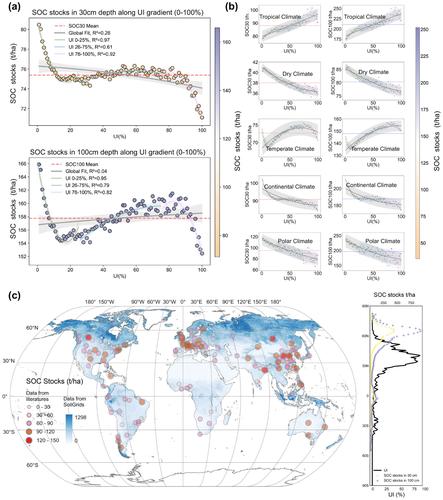当前位置:
X-MOL 学术
›
Glob. Change Biol.
›
论文详情
Our official English website, www.x-mol.net, welcomes your
feedback! (Note: you will need to create a separate account there.)
Dynamic Responses of Soil Organic Carbon to Urbanization: A Global Perspective
Global Change Biology ( IF 10.8 ) Pub Date : 2024-11-13 , DOI: 10.1111/gcb.17573 Fangjin Xu, Shuqing Zhao, Shuangcheng Li
Global Change Biology ( IF 10.8 ) Pub Date : 2024-11-13 , DOI: 10.1111/gcb.17573 Fangjin Xu, Shuqing Zhao, Shuangcheng Li

|
Rapid global urbanization has a complex impact on soil organic carbon (SOC) stocks. Through its direct and indirect impacts on soil formation and development, urbanization greatly influences SOC stocks. However, the extent to which urbanization affects SOC stocks globally remains unclear. In this study, we utilized an urban–rural gradient approach to assess the effects of urbanization on SOC stocks at both global and national scales. First, we calculated the urbanization intensity (UI) at a 1 km scale globally, categorizing urbanization into three stages: low (0 ≤ UI ≤ 25), medium (25 < UI ≤ 75), and high (75 < UI ≤ 100). Additionally, we distinguished the contributions of natural factors and human activities and analyzed the effects of land‐use changes in eight representative cities. We found the following: (1) The SOC stocks exhibit distinct trends with increasing UI, but when UI is low or high, an increase in UI is associated with decreasing SOC stocks (reductions of 6.8% and 5.4% at a depth of 30 cm; 6.4% and 3.2% at a depth of 100 cm, respectively). (2) Changes in human activities are the main drivers of SOC stock changes during urbanization. At low and medium urban intensities, the contributions of human activities reach 98% and 89%, respectively. Additionally, land‐use transitions are closely correlated with SOC stock changes, particularly in areas near the urban core, across different climate zones. (3) The response of SOC to urbanization varies across climatic zones. In water‐scarce arid climates, attention should be given to the negative effects of urbanization, and more targeted measures should be taken to enhance the carbon sequestration capacity of urban soils. This study provides valuable insights into the dynamic interplay between urbanization and SOC stocks, underscoring the need for tailored strategies to manage soil carbon in urban environments.
中文翻译:

土壤有机碳对城市化的动态响应:全球视角
全球快速城市化对土壤有机碳 (SOC) 储量产生了复杂的影响。城市化对土壤形成和发展的直接和间接影响极大地影响了土壤有机碳储量。然而,城市化对全球 SOC 存量的影响程度仍不清楚。在这项研究中,我们利用城乡梯度方法来评估城市化对全球和国家尺度 SOC 储量的影响。首先,我们计算了全球 1 km 尺度的城市化强度 (UI),将城市化分为三个阶段:低(0 ≤ UI ≤ 25)、中(25 < UI ≤ 75)和高(75 < UI ≤ 100)。此外,我们区分了自然因素和人类活动的贡献,并分析了 8 个代表性城市土地利用变化的影响。我们发现以下内容:(1) SOC 储量表现出明显的趋势,随着 UI 的增加,但当 UI 低或高时,UI 的增加与 SOC 储量的减少有关(在 30 cm 深度处分别减少了 6.8% 和 5.4%;在 100 cm 深度处分别减少了 6.4% 和 3.2%)。(2) 人类活动的变化是城市化过程中 SOC 存量变化的主要驱动力。在低城市强度和中等强度时,人类活动的贡献率分别达到 98% 和 89%。此外,土地利用转变与 SOC 储量变化密切相关,尤其是在城市核心附近不同气候区的地区。(3) 土壤有机碳对城市化的响应因气候带而异。在缺水干旱气候下,应关注城市化的负面影响,并应采取更有针对性的措施来增强城市土壤的碳封存能力。 这项研究为城市化和 SOC 储量之间的动态相互作用提供了有价值的见解,强调了制定定制策略来管理城市环境中土壤碳的必要性。
更新日期:2024-11-13
中文翻译:

土壤有机碳对城市化的动态响应:全球视角
全球快速城市化对土壤有机碳 (SOC) 储量产生了复杂的影响。城市化对土壤形成和发展的直接和间接影响极大地影响了土壤有机碳储量。然而,城市化对全球 SOC 存量的影响程度仍不清楚。在这项研究中,我们利用城乡梯度方法来评估城市化对全球和国家尺度 SOC 储量的影响。首先,我们计算了全球 1 km 尺度的城市化强度 (UI),将城市化分为三个阶段:低(0 ≤ UI ≤ 25)、中(25 < UI ≤ 75)和高(75 < UI ≤ 100)。此外,我们区分了自然因素和人类活动的贡献,并分析了 8 个代表性城市土地利用变化的影响。我们发现以下内容:(1) SOC 储量表现出明显的趋势,随着 UI 的增加,但当 UI 低或高时,UI 的增加与 SOC 储量的减少有关(在 30 cm 深度处分别减少了 6.8% 和 5.4%;在 100 cm 深度处分别减少了 6.4% 和 3.2%)。(2) 人类活动的变化是城市化过程中 SOC 存量变化的主要驱动力。在低城市强度和中等强度时,人类活动的贡献率分别达到 98% 和 89%。此外,土地利用转变与 SOC 储量变化密切相关,尤其是在城市核心附近不同气候区的地区。(3) 土壤有机碳对城市化的响应因气候带而异。在缺水干旱气候下,应关注城市化的负面影响,并应采取更有针对性的措施来增强城市土壤的碳封存能力。 这项研究为城市化和 SOC 储量之间的动态相互作用提供了有价值的见解,强调了制定定制策略来管理城市环境中土壤碳的必要性。


















































 京公网安备 11010802027423号
京公网安备 11010802027423号